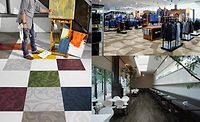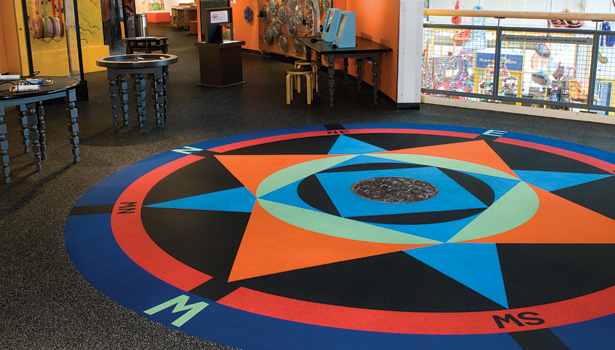Guest Column
Why Rubber is a Great Product for Commercial Applications

The diversity of what can be done with today’s recycled rubber floors is on display at the Long Island Children’s Museum in Garden City, N.Y., where 2,000-square-feet of Ecore’s ECOsurfaces flooring was used.

The Campus Center Apartments Fitness Center at the College of Charleston, S.C., includes 2,500-square-feet of Ecore’s Forest rx featuring the patent-pending “itstru” technology, which allows a vinyl wear layer that, in this case looks like wood, to be fusion-bonded to a recycled rubber underlayment.

The City Hall Academy at the Tweed Courthouse in New York is an education center that also includes Ecore’s ECOsurfaces for safety, comfort and noise control as well as educational purposes.

The $25 million, 700,000-sqaure-foot Spooky Nook Sports Complex in Manheim, Pa., is the largest indoor sports complex in the U.S., and features 8,000-square-feet of Everlast UltraTile, which has a patented ultra wearlayer on a molded base that creates unparalleled noise and shock absorption qualities.

Lori Dowling was named president of Ecore Commercial Flooring in 2011. Dowling’s entire career has focused on the business of commercial flooring. She had previously served as president and CEO of Starnet Commercial Flooring Cooperative and, prior to that, spent 16 years with Armstrong World Industries. For more information, call (203) 482-1530 or email ldowling@ecoreintl.com.





Mention rubber flooring and many people think of a raised circular design or coin top tile that has been very popular for decades. Rubber as a flooring material has been around since about the 1940s, starting with the smooth, marbleized design tile that was a workhorse product in all kinds of heavy traffic areas. Today, there are many different rubber tile textures in addition to smooth and circles, plus rubber sheet, stair treads, base and accessories.
What makes rubber special as a floor covering is exceptional durability and stain resistance—it’s almost impervious so it does not need the intensive maintenance of sealing and coating that other flooring materials do. Plus, being a very resilient material, it’s comfortable and quiet under foot and has excellent slip resistance characteristics. In addition, it’s very stable so when it’s installed over the right substrate with the right adhesive it stays put.
Rarely does a flooring product come along that seems to address almost all of the current requirements for commercial spaces.
Designs change, manufacturers consolidate and new stories are told. But as far as true solutions, they are rare in the flooring business. While rubber flooring in general is the exception, it is well worth taking a second look at recycled rubber to see how this product category can provide real solutions to flooring challenges.
Recycled rubber is a relatively new product with technology having been developed only in the mid 1980s. But it is now, almost 30 years later that recycled rubber is being recognized and embraced for all it can offer.
Traditionally, recycled rubber has been relegated to sports and fitness spaces. However, with new colors, visuals and, most importantly new technology, the product can be used with great success in a variety of commercial applications, including healthcare, education and hospitality facilities.
Always, the most enticing part of specifying this category is the environmental aspect of turning old/used tires into flooring solutions. There are no smoke and mirrors here; no greenwashing. Start with a tire; you don’t send it to the landfill and then end up with a floor.
It’s actually a simple and elegant story, but a verychallenging process. First, the tires have to be collected, then chopped into smaller pieces and then refined through an extensive cleaning process. All the steel from steel belted tires and the stones and rocks that embed themselves in a typical tire during its use have to be carefully and precisely removed.
This is why it is important to use a manufacturer that completely handles all the issues and challenges of this process and does not outsource or purchase ingredients from a third party. The manufacturer should do everything from soup-to-nuts in-house. This will provide the quality assurance needed to create a product that can withstand the applications for which it is used.
But in 2014, being green isn’t nearly good enough—especially when you are talking about the commercial market. Flooring needs to continue to solve facility requirements, and that’s where recycled rubber really starts to shine.
Taking its cue from the tire that started it all, recycled rubber provides a unique combination of force reduction and acoustic performance. Naturally inherent in the rubber, these two attributes make it the perfect solution for many commercial spaces.
Force reduction means the rubber absorbs the force of the fall and “cushions the blow.” So, children will be safer on playgrounds, adults will be safer in gyms and, most importantly, patients will be safer when an accidental fall from a hospital bed occurs.
It is no surprise one of the major concerns in all healthcare facilities is the injuries that take place from a patient or employee who falls on the floor. It is critical for these facilities to choose surfaces that mitigate the chance of a fall occurring and the severity of an injury when a fall does takes place. Products like Ecore Commercial Flooring’s new Forest rx have been tested to show force reduction of more than 17%. What other flooring category can show actual data, demonstrating the floors absorb the force from a fall?
An added side benefit related to this force reduction is the natural comfort underfoot that recycled rubber offers. Think of any location where an individual is standing for an extended period of time, and you will have a perfect space for using recycled rubber. Bank teller areas, pharmaceutical counters and nurses stations are all examples of places where recycled rubber is gaining a quick foothold over other traditional flooring options.
For example, Ecore’s ECOmax recycled rubber tile was recently installed in more than 100 Sovereign Bank locations all over New England.
Bottom line: It’s just common sense that if employees are more comfortable in their work environments, there will be less sickness and absenteeism, more productivity and, overall, workers will be happier.
In addition to the force reduction and comfort underfoot, the issue of noise control is another critical component of recycled rubber products. Both footfall and room-to-room noise are substantially reduced in a typical floor-to-ceiling assembly.
A special product category of rubber acoustical underlayments is becoming an integral part of multi-family construction, and the issue of noise control is at the top of many facility managers’ lists when choosing products. Recycled rubber is cost efficient, long lasting and doesn’t degrade over time, as many of the cushion and foam sound and vibration products can do.
Certainly with all of these strong reasons to choose recycled rubber, it is worth mentioning how much the visuals have also evolved. Today’s recycled rubber products are much more than a black background with colored specs. New products that explode with color provide a bright option for those looking for a cheerful space. Sophisticated neutrals such as Ecore’s ECOstudio line look like a beautiful granite or marble surface.
Even more exciting is a new line of laminated products, which utilize Ecore’s patent-pending “itstru” technology, to create surfaces that are fusion-bonded to the recycled rubber. This process provides an almost limitless amount of designs and patterns that can now take on all the properties of the recycled rubber.
Lastly, there isn’t much else in the flooring world of choices that is more durable than recycled rubber. When you start with a tire as your main raw material, you are assured that you will have an end product that is strong and long lasting. Common sense says the reason we don’t want to send tires to the landfill is because they don’t degrade over time; but, it’s the same reason we know tires make an incredibly durable, long-lasting flooring product.
Add it all up: An undisputable environmental story, tested force reduction for safety, acoustic properties, comfort underfoot, durability and unique designs, and the answer should be clear as to why rubber reamins a great product for commercial applications.
And beyond your standard rubber products, take a second look at recycled rubber: It’s not what you think, it’s so much more.
Lori Dowling was named president of Ecore Commercial Flooring in 2011. Dowling’s entire career has focused on the business of commercial flooring. She had previously served as president and CEO of Starnet Commercial Flooring Cooperative and, prior to that, spent 16 years with Armstrong World Industries. For more information, call (203) 482-1530 or email ldowling@ecoreintl.com.
Looking for a reprint of this article?
From high-res PDFs to custom plaques, order your copy today!













